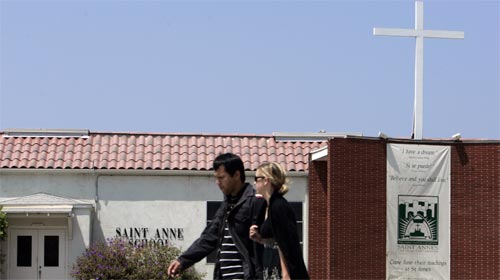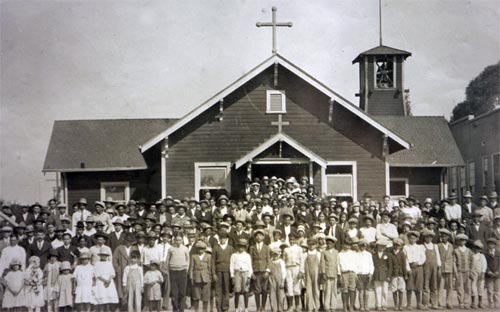Santa Monica's St. Anne Is a Case Study in How Some Parish Campuses Are Barely Hanging On
By Carla Rivera
Los Angeles Times
October 30, 2007
http://www.latimes.com/news/printedition/front/la-me-stanne30oct30,1,483201.story?coll=la-headlines-frontpage&track=crosspromo
Troubles at St. Anne Catholic School in Santa Monica were so dire at one point that Father Michael D. Gutierrez turned to his congregation for help. He refused to give his sermon until at least 10 families stepped forward to consider enrolling their children in the financially strapped parish school.
 |
| AFFORDABLE: Despite fiscal troubles, St. Anne Catholic School keeps its tuition low. It charged $2,650 per student last year, compared with the average of $4,330 at nine other local Catholic schools. Photo by Stephen Osman |
A grim economic reality has been building for years in the nation's Catholic schools: Hit by rising costs and tuition and declining enrollment, many are fighting for survival.
The Los Angeles Archdiocese, which recently announced the closing of Daniel Murphy Catholic High School, has been beset by the same pressures, with total enrollment dropping to about 62,000 this year from more than 100,000 seven years ago. The student body at Daniel Murphy, which is subsidized by the Archdiocese, had dropped to 231 students from more than 500, and the Fairfax-area school was in jeopardy of cutting back its curriculum.
 |
| SECOND-GRADE TEACHER: Randi Coy, 27, straightens up her classroom at St. Anne, which opened this fall with 200 students. Photo by Stephen Osman |
The number of Catholic schools in the United States declined by more than 850 from 1990 to 2005; scores of such institutions in New York, Detroit and St. Louis operating at deficits have closed in recent years. Also, multimillion-dollar financial settlements reached with victims of priest sexual abuse have created new financial stresses.
Enrollment has plummeted in some areas because the population -- especially young families with children -- has shifted from the urban core to the suburbs where there are fewer parishes and schools. Also, many low-income urban residents who might consider parochial schools cannot afford to pay the tuition.
 |
| CREATED FOR THE POOR: St. Anne was established in 1908 by a missions program to serve the children of migrant farm workers. Photo by Stephen Osman |
According to the National Catholic Education Assn., enrollment is at a low of 2.3 million students attending roughly 7,500 Catholic schools, and about 15% of Catholic children attend parochial schools.
Adding to the problems, the nuns and priests who were once classroom staples have largely disappeared, replaced by lay teachers who seek the same salaries and benefits as their public-school counterparts.
Los Angeles so far has bucked the large-scale school closing trend, and archdiocese officials said there was no plan to sell school properties to meet financial obligations. Wealthier parishes help subsidize poorer ones through an archdiocese program, Together in Mission, and a scholarship program was recently expanded.
But parishes and school principals in Los Angeles, Orange County and elsewhere are in a race to find creative solutions to problems that have been decades in the making.
 |
The experience of little St. Anne is a case study in how some schools are hanging on.
The school was founded in 1908 by the Sisters of the Holy Names of Jesus and Mary to serve the children of migrant farm workers tending the bean fields and orange groves that dotted the Westside. Today, St. Anne still caters to predominantly poor families who work in local businesses.
But it receives virtually no direct financial support from the Los Angeles Archdiocese, which allocates subsidies based on the median income of the community where the school is located. The 244 schools in the archdiocese are ranked on a scale from one to 10 in terms of neediness, and only schools at levels eight, nine or 10 receive money, said St. Anne Principal Michael Browning. (Some Catholic schools, such as Loyola High School near downtown L.A. and Notre Dame High School in Sherman Oaks, are independent and aren't funded by the archdiocese.)
Although St. Anne is near Santa Monica's working-class Pico area, it also is close to mixed-use businesses and relatively expensive homes, so the school ranks as a six. Without archdiocese support, it relies on tuition and private fundraising.
The school is a neighborhood mainstay even though 90% of its students don't live in Santa Monica. It enrolls students from as far as Palmdale whose parents work at nearby St. John's Health Center and other businesses. Seventy-eight percent of its students are Latino, and three-quarters live below the poverty line.
St. Monica Elementary School, which is just north of Wilshire Boulevard and roughly a mile from St. Anne, draws students from a wide income and ethnic mix. But only 5% of its students live below the poverty level, and tuition per child is about $4,000, falling in the middle of Westside Catholic schools, said Principal Joan R. Morris. Because of its location, St. Monica ranks low on the archdiocese scale and receives no subsidy. But the school has strong parental support and its own endowment.
The demographics at Browning's former school, Ascension Catholic School in South Los Angeles, resemble St. Anne's. But the 70-year-old Ascension campus, which is in a low-income area, is ranked a nine by the archdiocese. It receives about $140,000 annually in direct subsidies but still struggles to maintain enrollment, said Principal Karen Kallay.
St. Anne's revenues don't begin to cover the costs of educating its students, many of whom have most of their tuition waived so that they can remain in school. As the school has had to modestly increase tuition, enrollment has stalled or declined. With chronic operating deficits, St. Anne has struggled to stay open.
Browning reached out about 18 months ago to St. John's hospital for support, the headmaster at nearby Crossroads School solicited help from other private schools, and the St. Anne Support Council was created. It has raised more than $280,000 from its members (St. John's, for example, gives $50,000 annually to pay for a school nurse and counselor twice a week) and outside foundations to keep the school operating.
It also has benefited from the dynamic Father Gutierrez, whose social activism aligned with the school's historic traditions.
Although not completely out of the woods, St. Anne opened this fall with 200 students, remodeled classrooms and new music and science programs.
Any original material on these pages is copyright © BishopAccountability.org 2004. Reproduce freely with attribution.